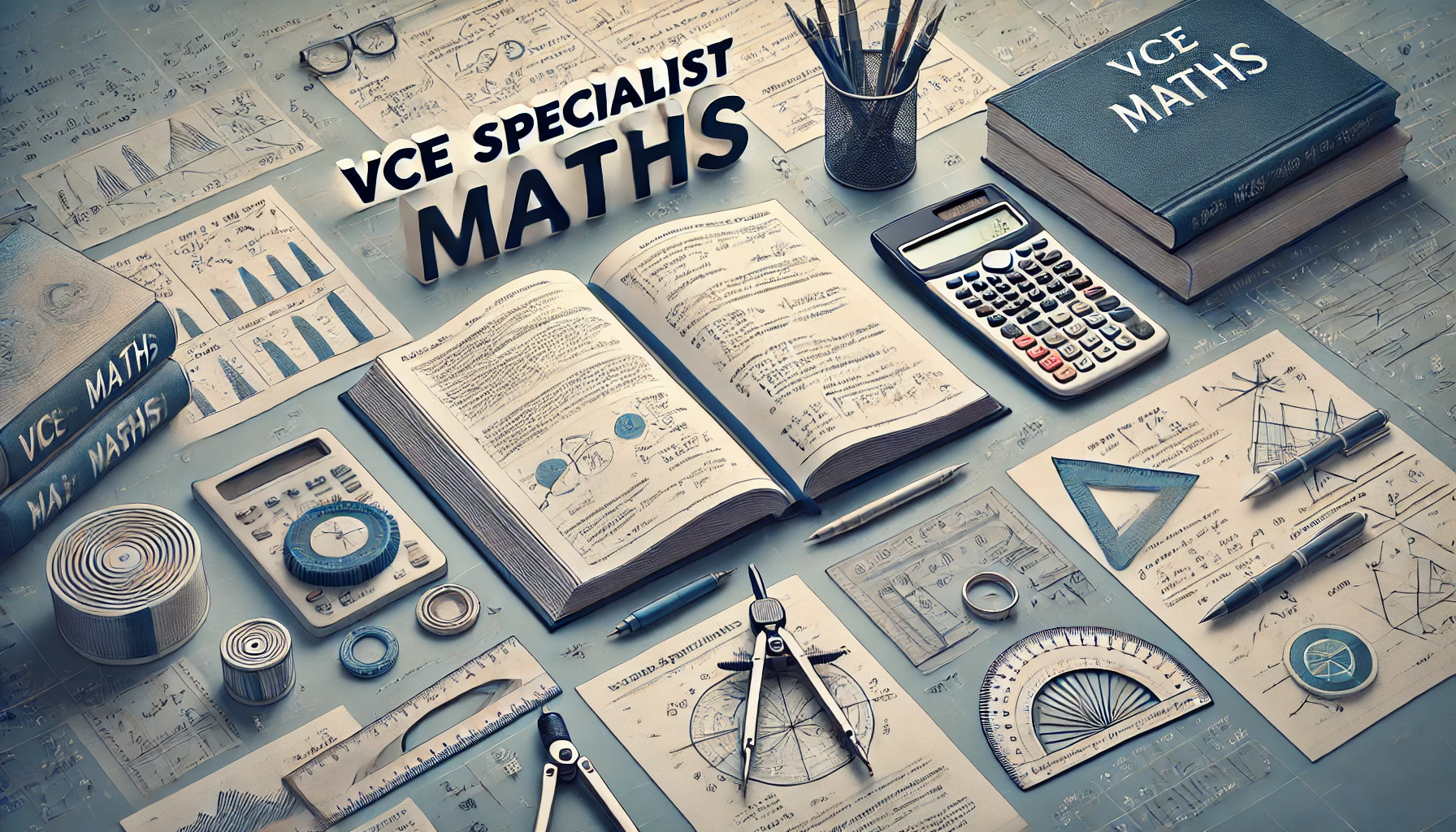
The VCE Specialist Mathematics exam consists of two papers, each designed to assess different aspects of students' mathematical understanding. While both papers cover the same curriculum, they differ in format, allowed resources, and the nature of the questions.
Paper 1 is often considered more challenging in terms of algebraic manipulation and requiring a deep understanding of core concepts, as students cannot rely on calculators. In contrast, Paper 2 allows the use of technology, which enables students to solve more complex problems that require numerical or graphical approaches.
Below is a comparative table summarising the key features of each exam.
Comparison of Paper 1 and Paper 2
💡Exams are a super important part to any student's journey. Ace your exams with confidence following these 10 detailed tips!
Question Breakdown for VCE Specialist Mathematics Examination 1
To gain deeper insights into the structure and difficulty of the Specialist Mathematics Examination 1, we have mapped each question to its corresponding topic and sub-topic from the syllabus. Additionally, the examiner's report provides data on student performance, showing the percentage of students who scored 0, 1, 2, or 3 marks per question.
This table offers an overview of the distribution of marks and highlights which areas of the syllabus students performed well in and which posed the greatest challenge.
Key Takeaways
- Strong Performance Areas: Students performed well in proof-based reasoning, particularly in direct proof (Question 2), and core calculus skills, such as implicit differentiation (Question 8a) and solving separable differential equations (Question 7). Many also demonstrated confidence in vector operations, including the cross product (Question 4b).
- Common Challenges: Topics such as graph sketching, kinematics, and 3D vector geometry posed difficulties, with a higher percentage of students scoring 0 or 1 mark. Graph sketching (Question 3c) was especially challenging, with many students failing to correctly identify asymptotes and intercepts. Applied calculus in kinematics (Question 9b) also saw common errors in differentiation and understanding velocity-acceleration relationships.
- Exam Strategy Implications: Students should focus on refining their graphing techniques, ensuring they correctly label key features such as asymptotes and intercepts. For kinematics and applied calculus, more emphasis should be placed on conceptual understanding rather than memorisation. Additionally, improving spatial reasoning in 3D vector problems will aid in tackling distance-related vector geometry questions (e.g., Question 10). Strengthening algebraic manipulation skills will also help prevent avoidable errors in multiple-step problems.
💡Check out why past papers are the best way to study for exams!
Key takeaways from Specialist Maths Examination 1 in 2024
Understanding the strengths and weaknesses demonstrated in the 2024 VCE Specialist Mathematics Examination 1 is crucial for future students. This section highlights the key skills that should be prioritised, advice from the examiners, and common mistakes that impacted student performance.
Key Skills to Focus On
- Graph sketching: Ensure correct placement of asymptotes, intercepts, and overall shape.
- Vector operations: Strengthen understanding of cross product and distance calculations in 3D space.
- Algebraic manipulation: Improve accuracy in solving equations, particularly in complex numbers and factorisation.
- Kinematics and applied calculus: Develop proficiency in differentiating motion equations and understanding acceleration.
- Proofs: Ensure logical structuring and completeness when proving results.
- Implicit differentiation: Apply correct differentiation rules and avoid algebraic errors.
Advice for Students
- Show full working: Marks are awarded for method as well as final answers.
- Use the formula sheet correctly: Misapplication of formulas was a common issue.
- Be precise with algebra: Small errors in algebraic manipulation cost marks.
- Check graph sketches: Ensure correct labelling of asymptotes, intercepts, and key points.
- Understand vector geometry: Improve spatial reasoning for 3D vector problems.
- Revise calculus applications: Ensure a strong grasp of differentiation in applied contexts.
💡Take notes efficiently and effectively using these tips!
Common Mistakes
- Incorrect graph sketches, with missing or misplaced asymptotes and intercepts.
- Errors in applying differentiation rules, particularly in kinematics problems.
- Misuse of formulas from the formula sheet, leading to incorrect answers.
- Algebraic errors in solving complex number equations and factorising expressions.
- Failure to show full working in proof-based questions, resulting in partial marks.
- Struggles with vector geometry, especially in computing distances between lines.

Question Breakdown for VCE Specialist Mathematics Examination 2
To gain a deeper understanding of student performance in Examination 2, each question has been mapped to its corresponding topic and sub-topic from the syllabus. Additionally, the examiner’s report provides data on student performance, detailing the percentage of students who scored 0, 1, 2, or 3 marks per question.
This breakdown helps identify which areas students excelled in and which posed challenges, guiding future study and revision strategies.
Key Takeaways
- Strong Performance Areas: Students demonstrated strong understanding in complex numbers and statistical hypothesis testing, particularly in finding equations of loci (Question 2a), circle equations (Question 2b), and confidence intervals (Question 6e). Additionally, rate of change and differential equations (Questions 3a, 3b) were well answered, showing competency in calculus applications.
- Common Challenges: Topics such as graph sketching, vector geometry, and applied calculus were particularly difficult for many students. Graphing accuracy (Question 1a) remained a challenge, with errors in positioning turning points and asymptotes. Vector-related problems (Questions 5a, 5c, and 4e) highlighted difficulties in 3D spatial reasoning, and definite integrals and differentiation techniques (Questions 1b.i, 1b.ii, 4c.ii) saw frequent algebraic mistakes and transcription errors.
- Exam Strategy Implications: Students should focus on improving their graphing accuracy by using their CAS calculators effectively while ensuring correct hand-drawn sketches. Strengthening vector problem-solving and 3D spatial awareness will aid in tackling geometric applications. Additionally, refining algebraic manipulation and differentiation techniques, particularly in applied calculus contexts, will help avoid errors that result in lost marks. Lastly, carefully reading exam instructions and ensuring correct answer formats will prevent unnecessary mistakes.
💡As students, we juggle assignments, exams, and more, often cramming last-minute. Let’s explore how effective habits can transform our academic journey!
Key takeaways from Specialist Maths Examination 2 in 2024
To improve performance in the VCE Specialist Mathematics Examination 2, it is essential to understand the specific skills required, take note of the examiner's advice, and be aware of common mistakes that students made in 2024. This section highlights these key aspects to help students refine their approach and achieve better results.
Key Skills to Focus on
- Graphing Accuracy: Ensure precise placement of asymptotes, intercepts, and turning points when sketching graphs.
- Vector Geometry: Improve spatial reasoning and understanding of vector equations, intersections, and distances in 3D space.
- Algebraic Manipulation: Reduce errors in complex number operations, polynomial division, and differentiation.
- Application of Calculus: Strengthen problem-solving skills in definite integrals, related rates, and kinematic equations.
- Statistical Methods: Be proficient in hypothesis testing, confidence intervals, and error probability calculations.
- Exam Technique and Precision: Carefully follow instructions, present clear working, and check for transcription errors when using CAS technology.
Advice for Students
- Show all working: Partial marks are awarded for method, even if the final answer is incorrect. Omitting key steps can result in a significant loss of marks.
- Use CAS technology effectively: While CAS calculators are useful, students must still demonstrate logical steps rather than relying solely on calculator output.
- Write answers in the correct form: If a question asks for an exact value, decimal approximations are not accepted unless explicitly required.
- Understand and apply formulas correctly: Many students incorrectly applied formulas from the reference sheet, particularly in differentiation, integration, and statistical calculations.
- Check graphical work: Ensure that asymptotes, turning points, and intercepts are accurately represented, especially in graph sketching questions.
- Read the question carefully: Many students lost marks by missing small but critical details in the problem statement, such as required units or answer formats.
💡Check out these scientifically proven strategies to improve how you study!
Common Mistakes
- Misinterpreting graphing questions, leading to incorrect asymptotes, mislabelled turning points, or missing key features.
- Errors in vector calculations, particularly in cross products, distances between lines, and vector equations of planes.
- Algebraic mistakes, including sign errors, incorrect factorisation, and misapplication of polynomial division techniques.
- Misuse of calculus formulas, such as incorrect differentiation of parametric equations and errors in setting up integrals.
- Failure to show complete working, especially in proof-based questions and multi-step calculations.
- Incorrect use of statistical formulas, leading to errors in hypothesis testing, confidence intervals, and probability calculations.
Conclusion
The analysis of the 2024 VCE Specialist Mathematics examination highlights both areas of strength and opportunities for improvement. While students demonstrated confidence in complex numbers, statistical methods, and core calculus applications, challenges remain in graph sketching, vector geometry, and applied differentiation.
By addressing these key areas and adopting a strategic approach to revision, students can build a strong mathematical foundation and approach the VCE Specialist Mathematics exam with confidence.






